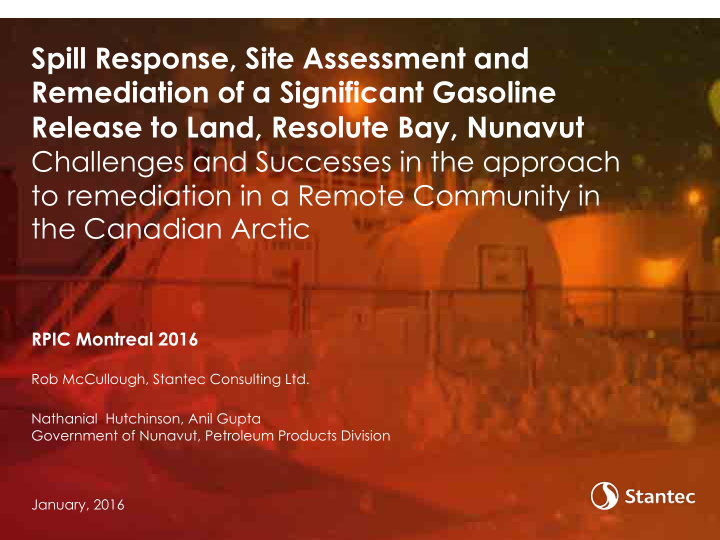



Spill Response, Site Assessment and Remediation of a Significant Gasoline Release to Land, Resolute Bay, Nunavut Challenges and Successes in the approach to remediation in a Remote Community in the Canadian Arctic RPIC Montreal 2016 Rob McCullough, Stantec Consulting Ltd. Nathanial Hutchinson, Anil Gupta Government of Nunavut, Petroleum Products Division January, 2016
Agenda 1 Background/Initial Assessment, 2011 2 Site Assessment 2012 3 Site Remediation 2012 - Present 4 Conclusions – Challenges, Successes and Lessons Learned
1 Background Location of release • October, 2011 • Est 87,000 L of gasoline • Valve failure – day tank • overfill Areal View of Former and Current Tank Farm in Resolute, NU
Site Conditions - Initial Challenges • Stantec on-site November 2011 to assess the release • 2 hours of daylight • Sub zero temperatures and multi-day blizzards • Heavy snow • Most contractors had returned to the south for the winter Location of Horizontal Tanks
Horizontal AST Surface Evaluation Fuel ran down the side of the • tank and onto gravel No definitive evidence of fuel • on the frozen ground Uncertainty as to whether a • fuel spill occurred Police investigation ongoing •
Snow in Catchment Basin Snow in Catchment Basin was in excess of 4 m deep and made hand assessment difficult with no heavy equipment available, limited visibility of hydrocarbons Cold temperatures mitigated vapor detection
2 Assessment Work in 2012 Snow was 2 to 3 m deep Hand excavation
Rhodamine Dye Application Applied 300 L of dye to the surface/subsurface
Test Pits in Catchment Basin Test pits Test pits excavated in catchment basin to assess the location of the fuel in the ice and snow
Test Pits in Catchment Basin (2) • Assessment of ice below the snow for the presence of gasoline • Fingerprinting of fuel from samples
Ice with Fuel in Catchment Basin Clean Ice Ice with Fuel
Melted Ice/Snow Up to 30 % gasoline by volume in melted sample Gasoline Water
Wildlife Hazards Bear Encounters Up to 30 % gasoline by volume in melted sample
Wildlife Hazards Bear Encounters Up to 30 % gasoline by volume in melted sample
Wildlife Hazards Bear Encounters Up to 30 % gasoline by volume in melted sample
Third Phase of Assessment, July 2012 Test pits excavated across tank farm area and down gradient locations
Third Phase of Assessment, July 2012 Test pits excavated across sea lift staging area down Test pits gradient of site Very difficult to differentiate contaminants in soil Staging area
3 Site Remediation
Silt Fence at High Water Mark
Ocean Boom in Resolute Bay
Cut Off Trench with HDPE Liner HDPE 60 mil welded liner
Perforated Drain Pipe in Trench h c n e r T f f o - t u C
Trenches Dug in Old Tank Farm Collection of water and phase separated product
On-Site Containment Cell Approximately 5000 m 3 of impacted soil placed in on-site constructed cell
On-Site Containment Cell (2) 60 mil HDPE liner welded in the field
Remedial Excavation at ASTs • Residual dye below tanks • Permafrost bowl under tanks
Main Excavation at Tank Farm Original AST location Excavated to permafrost across impacted zone
Main Excavation at Tank Farm (2) Berm from original tank farm lined and keyed to permafrost
Excavation on Road Exposed shale Bedrock
Backfilling of Road Excavation
Backfilling of Tank Farm Excavation
Reinstatement of ASTs
Remediation Support Equipment Generator, frost-biter, and fuel for equipment
GAC Water Treatment System
Effluent from Water Treatment
4 Lessons Learned • Sometimes very difficult to assess a release in Arctic conditions even when it should be obvious • Many Hazards to be aware of: cold temperatures, communications, wildlife, safety • Equipment available in the south is not necessarily available in remote Arctic location, need to improvise • Time lag on results and thus decisions • Very expensive in all aspects
4 Conclusions Tea + -50 o C = Iced Tea
Acknowledgements • Nathanial Hutchinson, Anil Gupta, Government of Nunavut, Petroleum Products Division • Kristi Lowe, Director of Environmental Protection, Department of the Environment Government of Nunavut • Patricio Fuentes, Regional Project Manager, Community and Government Services, Baffin Region, Government of Nunavut • Patrick Kramers, Curtis Didham, Environmental Enforcement Directorate, Enforcement Branch, Environment Canada
Questions? Robert McCullough, B.E.S., CET., CESA., EP Principal Stantec Dartmouth (902) 468-7777 Robert.mcculough@stantec.com
Recommend
More recommend